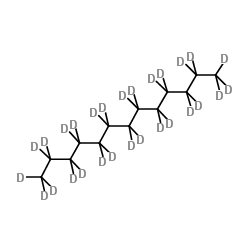(2H28)Tridecane
Modify Date: 2024-01-24 11:57:23

(2H28)Tridecane structure
|
Common Name | (2H28)Tridecane | ||
|---|---|---|---|---|
| CAS Number | 121578-12-9 | Molecular Weight | 212.534 | |
| Density | 0.8±0.1 g/cm3 | Boiling Point | 234.5±3.0 °C at 760 mmHg | |
| Molecular Formula | C13D28 | Melting Point | 2ºC | |
| MSDS | N/A | Flash Point | 101.7±0.0 °C | |
Use of (2H28)TridecaneTridecane-d28 is the deuterium labeled Tridecane[1]. Tridecane is a short chain aliphatic hydrocarbon containing 13 carbon atoms. Tridecane is an volatile oil component isolated from essential oil of Piper aduncum L. Tridecane is a stress compound released by the brown marmorated stink bugs stress compound[2][3]. |
| Name | n-tridecane-d28 |
|---|---|
| Synonym | More Synonyms |
| Description | Tridecane-d28 is the deuterium labeled Tridecane[1]. Tridecane is a short chain aliphatic hydrocarbon containing 13 carbon atoms. Tridecane is an volatile oil component isolated from essential oil of Piper aduncum L. Tridecane is a stress compound released by the brown marmorated stink bugs stress compound[2][3]. |
|---|---|
| Related Catalog | |
| In Vitro | Stable heavy isotopes of hydrogen, carbon, and other elements have been incorporated into drug molecules, largely as tracers for quantitation during the drug development process. Deuteration has gained attention because of its potential to affect the pharmacokinetic and metabolic profiles of drugs[1]. |
| References |
| Density | 0.8±0.1 g/cm3 |
|---|---|
| Boiling Point | 234.5±3.0 °C at 760 mmHg |
| Melting Point | 2ºC |
| Molecular Formula | C13D28 |
| Molecular Weight | 212.534 |
| Flash Point | 101.7±0.0 °C |
| Exact Mass | 212.394852 |
| LogP | 7.66 |
| Vapour Pressure | 0.1±0.2 mmHg at 25°C |
| Index of Refraction | 1.426 |
| (H)Tridecane |
| Tridecane-d |